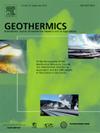Top-Down Cooling and Its Role in Sustaining the Laugarnes Geothermal Field, Iceland
IF 3.5
2区 工程技术
Q3 ENERGY & FUELS
引用次数: 0
Abstract
The Laugarnes geothermal field is a low-temperature system (<150 °C) that supplies an average of 80 MWth for district heating in Reykjavík. Over nearly a century of operation, the field has maintained stable pressures and discharge temperatures. Despite its longevity, the processes sustaining the reservoir's response to production are still not fully understood. This study analyzes long-term production and field data, revealing a "top-down" cooling pattern attributed to the recharge of cooler surface waters into shallow reservoir rocks. This phenomenon is then integrated into a new conceptual model of the field. Energy balance calculations – accounting for basal conductive heat flux, drawdown-induced surface recharge, and the associated cooling of the rock – demonstrate that formation cooling constitutes a significant heat source during production. A 3D numerical model, calibrated against natural-state temperature and pressure history, reproduces the observed temperature changes, further supporting the importance of heat extraction from the rock formation. The findings suggest an alternative paradigm for the understanding heat budget and transport in Laugarnes and highlight the broader relevance of recharge-driven heat extraction in low-temperature systems. Therefore, considering this process is crucial for accurately characterizing low-temperature systems and ensuring their sustainable use.
自上而下的冷却及其在维持冰岛Laugarnes地热田中的作用
Laugarnes地热田是一个低温系统(<150°C),为Reykjavík提供平均80兆瓦的区域供热。在近一个世纪的运行中,该油田一直保持稳定的压力和排放温度。尽管其寿命很长,但维持储层对产量响应的过程仍未完全了解。该研究分析了长期的生产和现场数据,揭示了一种“自上而下”的冷却模式,这种模式归因于较冷的地表水重新注入浅层储层岩石。然后将这种现象整合到该领域的新概念模型中。能量平衡计算——考虑到基本的传导热通量、由下降引起的地表补给以及岩石的相关冷却——表明,地层冷却是生产过程中一个重要的热源。根据自然状态温度和压力历史校准的3D数值模型再现了观测到的温度变化,进一步支持了从岩层中提取热量的重要性。该研究结果为理解Laugarnes地区的热量收支和输送提供了另一种范式,并强调了低温系统中补给驱动的热量提取的广泛相关性。因此,考虑这一过程对于准确表征低温系统并确保其可持续利用至关重要。
本文章由计算机程序翻译,如有差异,请以英文原文为准。
求助全文
约1分钟内获得全文
求助全文
来源期刊

Geothermics
工程技术-地球科学综合
CiteScore
7.70
自引率
15.40%
发文量
237
审稿时长
4.5 months
期刊介绍:
Geothermics is an international journal devoted to the research and development of geothermal energy. The International Board of Editors of Geothermics, which comprises specialists in the various aspects of geothermal resources, exploration and development, guarantees the balanced, comprehensive view of scientific and technological developments in this promising energy field.
It promulgates the state of the art and science of geothermal energy, its exploration and exploitation through a regular exchange of information from all parts of the world. The journal publishes articles dealing with the theory, exploration techniques and all aspects of the utilization of geothermal resources. Geothermics serves as the scientific house, or exchange medium, through which the growing community of geothermal specialists can provide and receive information.
 求助内容:
求助内容: 应助结果提醒方式:
应助结果提醒方式:


